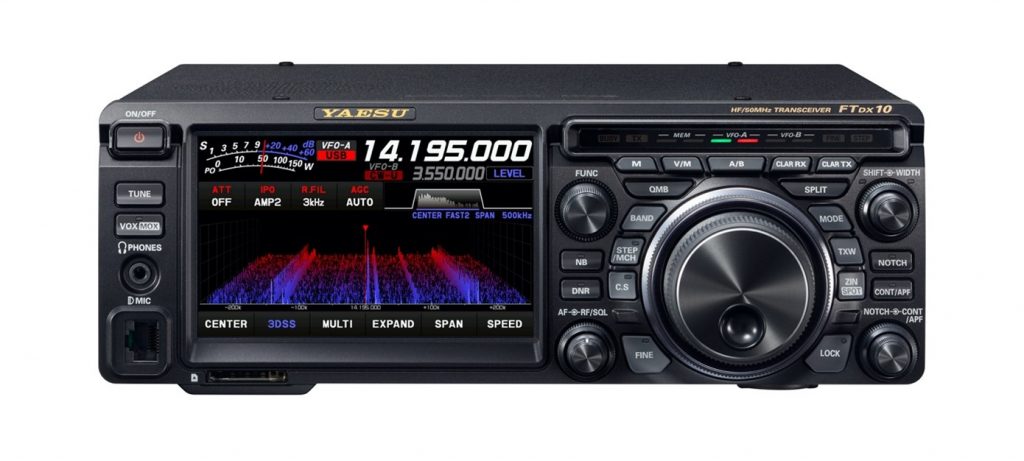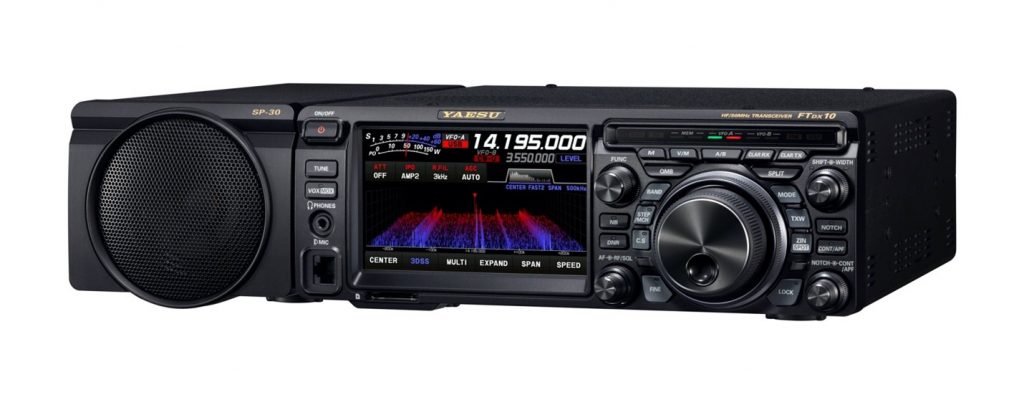If you make one of the best HF transceivers on the market, what do you do for an encore? You make another radio with excellent receiver performance that incorporates some of the best technology available–and is more affordable.
A look at the Yaesu FTDX10’s specs verifies that its designers incorporated some important features from the FTDX101D in the new transceiver. It also seems they took a hard look at the successful IC-7300 and built a medium-priced hybrid SDR to give Icom some serious competition. The FTDX10 is now number three (when this review was written) on Rob Sherwood’s receiver test data table—a table sorted by third-order dynamic range, narrow spaced. It’s not a bad place to be.

Out of the Box
The FTDX10 comes in an enclosure that measures 3.5 x 10.5 x 10.5 inches and weighs 13 pounds. It’s solidly built, and the fit and finish are excellent. It bears a strong resemblance to Yaesu’s FT-991A, but is a bit larger to accommodate the five-inch TFT touch screen/display. Knob and button locations have been adjusted to fit the larger display. Some additional settings were moved to the function screen to provide more space.
Continuous receive coverage is available from 30 kHz through 75 MHz, with transmit coverage for the amateur bands. Operating modes include AM, FM, SSB, CW, and digital, with built-in decoders for CW, RTTY, and PSK31. The FTDX10 also offers voice memories for use on AM, SSB, or FM. You can record up to five individual messages, each with a maximum time limit of 90 seconds, and then save them to the SD memory card for quick access.
Hybrid SDR
Let’s take a quick look at the circuitry behind the FTDX10’s refined receive capabilities. Yaesu has chosen to follow the hybrid route, employing the best of both SDR and conventional superheterodyne technologies.
Like the FTDX101 series, the FTDX10 utilizes narrow band SDR and direct sampling SDR. The narrow band SDR provides excellent receive performance by removing strong out-of-band signals using superheterodyne technology and roofing filters, then converting them to digital. A direct sampling SDR provides digital processing for a real-time spectrum scope.

The front end has 15 input bandpass filters: 10 cover the amateur bands and the remaining five provide general coverage filtering. The FTDX10 doesn’t use a preselector like the FTDX101–one major difference between the two. Two switchable preamps providing 10/20 dB gain and three levels of attenuation, 6/12/18 dB, are available. The mixer uses eight dual-gate FETs producing high dynamic range.
Received signals are converted to 9 MHz and are processed through an analog stage featuring three selectable roofing filters at 500 Hz, 3 kHz, and 12 kHz. All this takes place before signals are down converted to 24 kHz, where the direct-sampling software-defined stage goes to work. It’s here that you get the benefits of enhanced software processing.
Controls and Connections
At first glance, the most obvious features of the FTDX10 are its five-inch TFT color touchscreen and an extra VFO knob. Most of the remaining buttons and controls are clustered around the VFO, along with a row of LED indicators on top. To the left of the display is the ON/OFF switch, the TUNE button which activates the built-in antenna tuner, a 3.5-millimeter headphone jack, and an RJ-45 modular-type microphone jack. The front panel also includes an SD memory card slot for easy access.
Anything not covered in the list above is accessed via the FUNC knob. Yaesu is known for their menus, and it’s one solution for keeping all the settings accessible and reasonably organized. When you press the FUNC knob, an array of settings, from break-in to VOX, appears. By turning the knob, or touching the item on the screen, you can choose and adjust individual levels. Across the bottom of the screen are five sub-menu buttons that cover additional settings.
You’ll find the multipurpose VFO outer dial, or MPVD, takes the form of a simple ring at the base of the VFO knob. Move the ring in its default mode and you’ll zip across the band at 10x the frequency step that’s set for the main knob–convenient when you want to change frequencies fast.
But wait, there’s more. You can instantly change the function of the ring by pressing the BAND, STEP, MODE, CLAR RX, or CLAR TX buttons. Say you’re operating SSB at the top end of 20 meters but want to switch to CW and operate at the bottom of the band instead. Twist the MPVD a few times and you’ll find yourself many kilohertz lower than where you started. Next, press the MODE button, and when the mode menu appears, twist the ring again to select CW. And if that wasn’t enough, you can configure the MPVD to adjust one of 16 separate custom functions.
The rear panel is covered with a variety of connectors. Other than the dc power plug, the ports are devoted to connecting a variety of external devices. A six-pin DIN jack is used for external digital-mode hardware for RTTY, PACTOR, packet, or other modes. An eight-pin DIN jack is compatible with an optional Yaesu FC-40 external antenna tuner.
A 10-pin DIN jack includes linear amplifier connections, plus band data and other signals for Yaesu’s VL-1000 amplifier. The FTDX10 provides a total of three USB ports: a USB-B jack for computer-aided operation (CAT) communication, transmit/receive switching, and audio data, plus two USB-A jacks for a keyboard and a mouse. Rounding out the back panel, you’ll find the CW key and external speaker jacks.
The Display
One of the features shared with the FTDX101D is the 3D panoramic display–a bit of eye candy for the ham operator. By reducing the waterfall gain until the signal peaks are shown without the background noise, the display looks much better. You can also select how much of the spectrum is shown at any one time. Also, it can drive an external display monitor to see what is on the FTDX10’s display in a larger format.
The FTDX10’s built-in display is larger than the ones included in the FT-991A and IC-7300. This is good, because rather than choosing between separate menu screens, you have room to include everything on one. The numerous choices may appear daunting at first, but once you have adjusted the parameters to your liking, there will only be a select few that you’re likely to change.
When you select buttons, such as band or mode, a smaller window pops up. For reasons unknown, this sub-menu closes automatically after just a few seconds. You have to choose quickly before the window disappears. This also happens on other Yaesu models, including the FT-891. It would be less frustrating if the screen disappeared only after a selection is made.
CW and Digital Modes
The FTDX10 is a capable CW contest rig, given its receive performance, with full-break-in (QSK) and semi break-in transmit operation supported. As with the voice memories, the CW keyer memories can be sent by using virtual buttons on the display or the optional FH-2 remote control keypad.
The FTDX10 offers a CW decoder with a pop-up “tuning bar” that helps you zero in on the signal. You also have to carefully tune the signal, tweak the filtering and DSP if needed, and adjust a control to match the speed of the other operator for best results. It also supports PSK and RTTY decoding and macros, but not a keyboard for free-form casual chatting–which is true of all the digital modes.
If you want full keyboard capabilities in all these modes, a computer connection is provided. You’ll need a USB A-B cable and a Virtual COM port driver available on the Yaesu website.
By using the built-in message memories, the FTDX10 has the potential to do contesting without using an external computer. The FTDX10’s PSK31 decoder appeared to be more accurate than the RTTY decoder. Successfully tuning a signal requires practice, but once you hit the sweet spot, the decoder does a reasonably good job.
On the Air
I primarily work SSB and a little bit of digital. Two things were apparent right away–the receiver was quieter than I’m used to, even in my closely packed suburban neighborhood that generates a fair amount of RFI. The second was the quality of the transmit and receive audio.
The Noise Blanker actually gets rid of power line noise–good because there are overhead power lines close by. Yaesu DSP noise reduction is aggressive, yet the resulting audio sounds natural with minimal digital artifacts. Add to this some manipulation of the IF bandwidths and it did a respectable job of separating signals from the garbage to successfully pull more stations out of the interference. There’s a lot of flexibility when it comes to tailoring the frequency response with the adjustable receiver audio filter, and it provides an array of high- and low-cut frequency settings for each mode, including the digital modes. I found that tweaking this feature often made a difference in intelligibility, especially when operating CW or SSB.
In the data modes, the decoder worked well, even with weak signals. The CW decoder was competent as well, with its accuracy compromised only by QRM or poorly sent code. Adjusting the speed tracking made a difference.
Unsolicited audio reports were always positive when using the supplied hand microphone or the Heil Pro headset I often use. Cutting off the bass end at 200Hz and tweaking the midrange around 200KHz helps intelligibility. Transmit is clean and, according to the ARRL labs, the IMD numbers are better than most.
The FTDX10’s internal automatic antenna tuner is designed to handle impedance mismatches that produce an SWR of 3:1 or less at the antenna port. The tuner activates with a push of the TUNE button, and you’ll hear the relays go to work for a couple of seconds as it attempts to find a match. It could handle just about anything on my 80-10m W2AU/W2VS dipole antenna, with the exception of the high end of 75m.
Final Thoughts
With the FTDX-1200 and FTDX-3000 discontinued, the FTDX10 fits nicely between the FT-991A and the FTDX101. It includes a very capable receiver and is suitable for casual contacts or serious contesting, but at a midrange price that’s only a few hundred more than the IC-7300.
My wish list for future updates would include the inclusion of FT8 in the digital features. Given the popularity of WSJT-X modes, it would be a welcome feature. The ability to type directly from a keyboard in real-time for QSOs would eliminate the need for an external computer.
Available Accessories
DP-30 Desktop Speaker: Provides enhanced intelligibility and reduced listening fatigue.

FH-2 Remote Keypad: Provides fingertip access to transceiver keyer messages. It also provides Audio Message Memory commands and selections.
SCU-LAN10 Network Remote Control System: Equip your Yaesu FTDX10 transceiver for Internet LAN remote control operations.
FC-40 Remote Antenna Tuner: FC-40 remote tuners are designed for operation on 7 to 54 MHz, when using an 8.5 foot whip, or on 1.8 to 54 MHz when used with a random-length wire longer than 66 feet.
Roofing Filter 300Hz: Narrow filter for improved CW copy.

